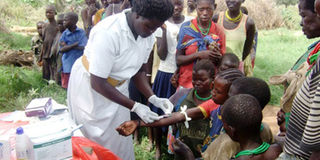How Uganda’s fight with ‘new disease’ became continent’s success story

A medical worker takes a blood sample from a karimojong woman to test for HIV at Iriir Health Centre III in Napak District recently. Uganda has been at the forefront in the fight against the epidemic over the last three decades. PHOTO by Steven Ariong.
What you need to know:
Three decades into the HIV/Aids pandemic, the picture continues to look bleak both globally and nationally. In the three part series starting today, we explore how Uganda became a global success story in the HIV/Aids fight, what went wrong and what it will take to get the prevalence moving down again.
Kampala
“A new disease has recently been recognised in rural Uganda. Because the major symptoms are weight loss and diarrhoea, it is known locally as slim disease,” wrote a team of scientists led by Makerere University’s Prof. David Serwadda, in the October 19, 1985 issue of the acclaimed medical journal, The Lancet. The article was among the first scientific publications on what turned out to be known as the human immunodeficiency virus, or HIV.
According the World Health Organisation, “the human immunodeficiency virus is a retrovirus that infects cells of the immune system, destroying or impairing their function. As the infection progresses, the immune system becomes weaker, and the person becomes more susceptible to infections. The most advanced stage of HIV infection is acquired immunodeficiency syndrome (Aids). It can take 10-15 years for an HIV-infected person to develop Aids; antiretroviral drugs can slow down the process even further.”
The Lancet article confirmed a December 29, 1984 front page lead story titled, “Mysterious Disease Kills 100 People in Rakai”, in The Star newspaper. The article, believed to have pioneered Aids reporting, had prompted scientists such as Prof. Serwadda and others to rush to Rakai and start investigating the new disease.
Even at that early stage, the scientists noted that “slim disease occurs predominantly in the heterosexually promiscuous population and there is no clear evidence to implicate other possible means of transmission, such as by insect vectors or re-used injection needles”.
But they did not clearly understand the new disease, and there was little they could do to ease the suffering. The future looked bleak during what is now referred to as the first phase of the epidemic, from 1982 to around 1991.
The 1989 images of the late music legend, Philly Lutaaya, who turned hero in the resultant fight against the pandemic by defying shame and disclosing his HIV-positive status, and others like him, shall forever remain etched in the minds of those who were able to comprehend things back then.
What followed in the second phase, which lasted up to 2000, was a classic triumph-over-adversity story that saw Uganda held up as a model for Africa in the fight against HIV/Aids. A 2003 article in the African Journal of Aids Research showed that HIV prevalence in the country declined from 21.1 to 9.7 per cent from 1991 to 1998 across 15 antenatal clinics. Similarly, the decline was from 18.5 to four per cent (1991–2002) in 21-year-old army recruits. While in another notable shift, HIV prevalence fell from 24 to 7 per cent (1989–1998), among blood donors.
The success story
Overall, prevalence had reduced dramatically from a 1991 average peak of 15 per cent to five per cent in 2001 among the 15 to 49 age group. Although progress now seems to have stalled, the 1990s downward spiral of prevalence is a feat that will never be erased in the 30-year history of HIV/Aids.
What did Uganda do to turn around a situation of hopelessness and haplessness into a hopeful one?
Uganda’s success story is not attributable to a single factor. Some of the country’s leading brains, who spoke to the Daily Monitor for this article, as well as scientific literature, point to several factors that contributed to the successes of the 1990s.
One is a grim statistical reality. As with the beginnings of other killer epidemics, the high death rate helped pull down the overall prevalence rate, according to Dr Noah Kiwanuka, the country director of the International Aids Vaccine Initiative, which is based at the Uganda Virus Research Institute in Entebbe.
“When the death rate is high, the number of cases of the disease will decrease, not because the new cases are less but because existing cases are already dying so fast. That has nothing to do with any behaviour interventions that people have made,” explained Dr Kiwanuka. He said even though health workers had limited knowledge of what to do about the situation then, the high death rate could have scared people into sexual behaviour modification.
“The deaths, the faces, and the many orphans scared people into changing behaviour,” Dr Hannah Kibuuka, of the Makerere University Walter Reed Project, also opined. “People were thin, had bad skin, you could easily tell. And that psychologically had an impact on people.”
Campaign strategies
When Dr Sam Okware and his colleagues at the Aids Control Programme of the Health ministry, drafted some of the very first behaviour change strategies, instilling fear among people was a key element in making people realise the emergence of a new threat. Experts in behaviour change have shown that fear can influence behaviour and, if it is channelled appropriately, it can motivate people to seek information.
Therefore, the first public service announcements on HIV/Aids were deliberately ominous, preceded and followed by drum beats and punctuated by skeletons, graves, and empty houses. But fear does not work forever, and it quickly became apparent that many people were becoming insensitive to it and unmoved by calls for behaviour change. So, the experts broadened their prevention options to include appeals for condom use and abstinence.
“To mount a sustained response, a high-profile political effort was made to create an environment in which the need for openness about HIV/Aids was recognised,” Dr Okware and other scientists wrote in a 2001 article in a bulletin of the World Health Organisation. “Responsibility for bringing this about was decentralised to the sectoral, district and community levels, through legislative, administrative and political directives.”
The public-education effort included mass campaigns by government and political leaders, including President Museveni, with support from community resource people and networks of people with or affected by HIV/Aids such as TASO (The Aids Support Organisation) through the mass media and folk media.
In addition to a new army of health educators that was formed at national, district and county levels to promote awareness and safe sexual practices, a similar and parallel network was created in educational institutions to promote peer-influence skills in the prevention and control of the Aids pandemic.
IAVI’s Dr Kiwanuka said the multi-sectoral education approach embraced by the government was the other major biggest component, which contributed to reduction in HIV cases. “From a medical condition, HIV/Aids was turned into a social issue as well. There was much political support - every politician talked about it, religious leaders, basically everybody talked about it. They would say, ‘This is sexually transmitted; avoid sex with unknown people, etc.’ That aggressive intervention, the fatal nature of the scourge then, and the high death rate all contributed to lowering the prevalence.”
The Uganda Aids Commission chairperson, Prof. Vinand Nantulya, said what pulled the country through the initial phase of the epidemic was an integrated strategy. “A [Abstinence] was applied where A [Abstinence], applied, B [Being faithful] was applied where B applied, and C [Condom use] was applied where C applied,” said Prof Nantulya, at a public debate recently where panellists discussed whether Uganda was moving in the right direction on HIV prevention.
The debate was part the activities to mark 90 years of Makerere University, which has conducted key HIV research over the years. But the national response did not only end at promoting behaviour change and legislation. A flurry of activities saw institutions set up or strengthened, especially at the national level, to provide services, conduct research, and act as training centres for staff. The Uganda Virus Research Institute, for instance, saw its capacity boosted for laboratory monitoring of HIV infection, antiretroviral drug use which had just come on board, and surveillance.
The National Blood Transfusion Services got strengthened to ensure safe donation and distribution of clean blood, while the Joint Clinical Research Centre was positioned to play a pivotal role in management of HIV/Aids patients and carry out vaccine evaluation studies.
US aid
The icing on these achievements came in the form of the US president’s Emergency Plan for Aids Relief (PEPFAR) and the Global Fund to fight HIV, Tuberculosis and Malaria, as the epidemic entered a stabilisation phase around 2003. Money flooded into the country, enabling thousands of persons living with HIV/Aids to get treatment. Prevention, as well as care and social support programmes, also saw a boost. But could the dollars have marked the beginning of the fall from grace to grass?
In the second instalment of this three-part series tomorrow, we shall explore what might have gone wrong with new data showing that prevalence is going up again.




